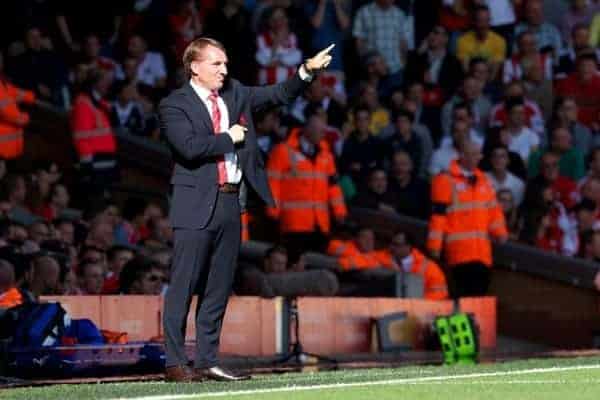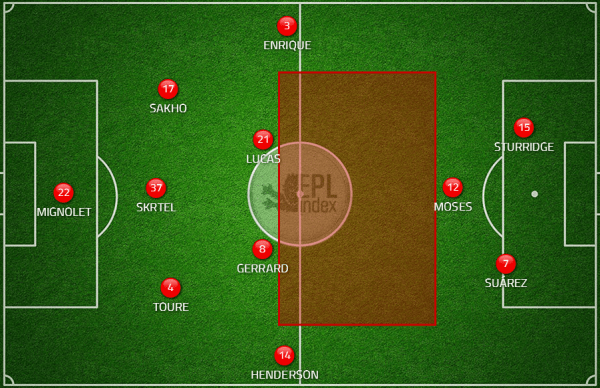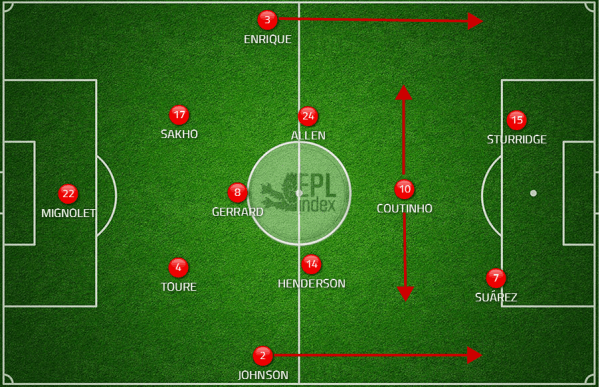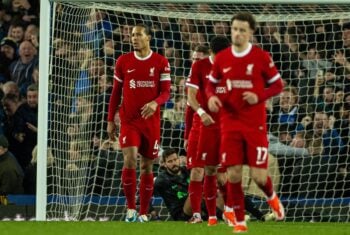Adam Griffies (@whatahitsonlfc)discusses the midfield balance and how a change in shape could lead to Brendan Rodgers’ desire to control games better becoming reality.

So far this season, Brendan Rodgers has deployed a couple of different systems as the Northern Irishman yearns for his side to recapture the control and tactical discipline they displayed for periods of 2012/13. Thus far though, Rodgers’ ideological style has remained elusive.
Most recently, of course, the Reds have lined up in a 3-4-1-2 formation: an inventive setup, but is it here to stay?
In the three games it’s been used, Liverpool have scored six goals and conceded three: not a bad record. But in my opinion – and seemingly Brendan Rodgers’ – performances have been disjointed and sporadic. The primary reason for this is the spatial disparity between our two central midfielders and the ‘number 10’; this gap results in a lack of fluidity in our play and often forces a midfielder or defender to look for a long, hopeful pass.
Rodgers echoed this point on Saturday after the Crystal Palace match:
“We need to be better with the ball – we put the ball at risk too much. That’s part of the system and with the players that we’ve lost; we have five players out injured and some of those are key players for us.”
The manager then, significantly, spoke about our recent change of shape:
“It has meant a shift in the structure. Sometimes 3-5-2 is set up more for the counter-attack. Overall, we need to make improvements with the ball – it’s very important for us.”

Pleasingly, for me, this point suggests the current system is not in Rodgers’ long-term plans, and its recent use has been consequential of pragmatism in light of injuries to the likes of Glen Johnson, Joe Allen and Philippe Coutinho.
The final point I’d like to make regarding this formation, and indeed any which employs three centre-backs, is the space vacated defensively down either wing: at the sides of the central defenders and behind the wing-backs. It is a transparent deficiency which can easily be pinpointed and exploited by the opposition.
So I’ve made it clear that the 3-4-1-2 is not for me. What’s my solution, then?
First and foremost, I want to underline what I think is the cornerstone of any successful system: central numbers and domination. By ‘central’, I mean vertically, not horizontally.
For example, a flat 4-4-2 is less populated centrally than a 4-3-3 – despite seemingly operating with one more midfielder. This is because the former structure, in reality, has just two central midfielders (with wingers staying wide), compared to a middle trio in the 4-3-3. Subsequently, the 4-3-3 allows more controlled, fluent and precise play in midfield, as the players are stationed closer to each other.
Whilst trying to gain an advantage tactically with a formation, Brendan Rodgers will not want to compromise his players’ natural ability and individuality. The key is to find a balance; deploying players in their most effective positions, within a logical system.
That is where the narrow diamond comes in. Fundamentally a distorted 4-4-2 structure, the narrow diamond provides tactical control whilst also suiting Liverpool’s squad, particularly in attacking areas. A fluent four down the spine of central midfield allows exact, technical passing and numerical supremacy in this area, resulting almost certainly in a much needed improvement in ball retention. Also, perhaps most significantly, the system accommodates Philippe Coutinho (‘in the hole’), Luis Suarez and Daniel Sturridge centrally, where they are all, in my view, at their most menacing.

The narrow diamond shape I’d like to see Brendan Rodgers employ.
“Where’s the width?” I can almost hear you sceptically whispering to yourself as you read this. It would, of course, be provided by our naturally attacking and marauding full-backs: Glen Johnson and Jose Enrique or Aly Cissokho. What’s the point of possessing such offensive players in these positions if we’re going to deploy wide men further forward, basically doing their job for them? Exactly, there isn’t.
My theory is by allowing your attacking full-backs to tend to wide areas of the pitch, you can then take advantage of the lack of necessity to deploy a wide player in midfield/attack, to station an extra body infield and dominate centrally. In other words, why get two players (a full-back and a winger) to provide width: a duty that one player is capable of doing.
There is, admittedly, one slight snag in reverting to this system and back to a four in defence: Rodgers would be forced to select just two from an array of at least four impressive centre-backs in his squad. As snags go, though, this is relatively mild and I would be surprised if something like this affected a decision from the manager.
To condense what I have said, the Reds, in my opinion, have to improve in general play; finding a system which balances tactical control and suits the players’ attributes is vital. The narrow diamond is the answer, as far as I am concerned.
Let’s be clear though, Liverpool will continue to win games even if they don’t develop, purely because of the individual brilliance of Daniel Sturridge, Luis Suarez and Philippe Coutinho in attack. Fundamentally, then, the level of your desire for us to improve comes down to personal preference: do you care how we win or, solely, if we win? If it is the latter, reading this piece was probably a waste of time. For me and, as he indicated on Saturday, Brendan Rodgers, the manner of our performance is important.

















Fan Comments